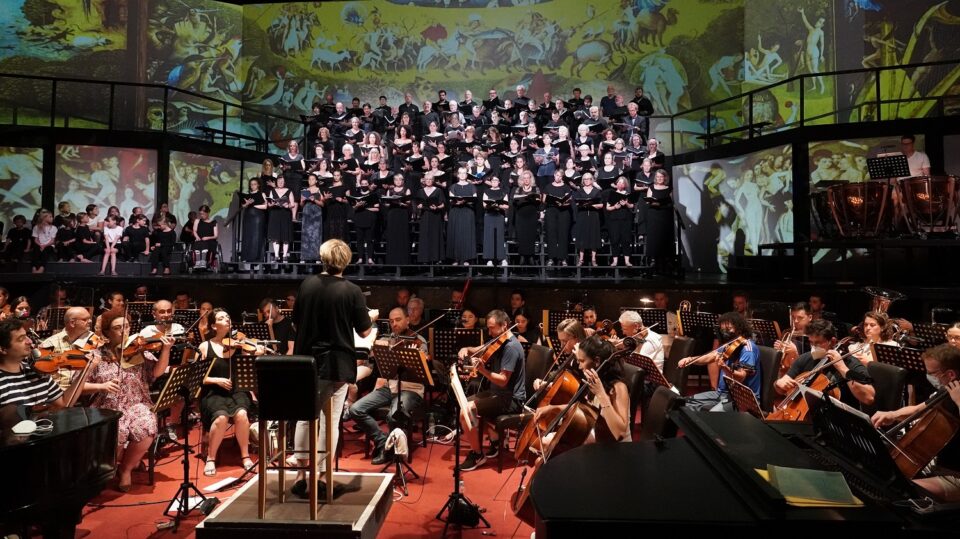Gustav Mahler’s 2nd Symphony

Change your life – without a guidebook or course
Are you looking for a way to give your life a new direction, to know that it’s worth it and that everything will be okay – but you don’t want to read guidebooks or take expensive courses? We have just the thing for you!
One choir member describes it this way:
Hearing Gustav Mahler’s 2nd Symphony as a recording is a wonderful discovery. Seeing them live is an overwhelming experience. Participating in a performance as part of the choir is life changing! Mahler’s 2nd Symphony is certainly one of the most emotional moments of my life – after an emotional roller coaster ride in which we confront ourselves, he dismisses us with the comforting thought that everything will be all right.
When Gustav Mahler, the oddball with big ambitions and a talent for bluster and religious confusion, wrote his second symphony, it was clear that its popularity would extend far beyond his lifetime. Conceived along the lines of “Per aspera ad astra” (through hardship one reaches the stars), the symphony is also known as the “Resurrection Symphony” (this addition is not Mahler’s), but it goes far beyond a purely religious piece. Mahler wanted to illuminate life and death in all its terrifying, deadly glory.
The reactions of the audience at the premiere showed clear overstrain, the critics spoke of “scandal, mischief, subversion”. Only a few, like Johannes Brahms or Anton Webern, saw the incomparable beauty of this symphony. Today, it is one of the top 100 pieces of classical music and is readily and frequently performed by the world’s leading orchestras.
Here are a few more reasons why you should definitely listen to Mahler’s 2nd Symphony: Not only is it one of the longest symphonies-90 minutes of life-changing music-but it also has extraordinary emotional depth and intensity. Mahler’s notes in the score alone suggest that this is an exceptional piece.
“From here on, imperceptibly, gradually change to a somewhat tighter tempo” – such instructions suit conductor Cornelia von Kerssenbrock, known for her sensitive conducting, particularly well, since she has a good command of the nuances. But there is also this instruction: “with humor”! Seriously! An instruction in the score!
Gustav Mahler wanted to describe the whole world and human existence. He attempted this in nine deeply personal symphonies of epic proportions. In the second symphony, he asks two big questions, “What happens after death?” and “What is the meaning of life?” The answer begins with a funeral….
We review life with its existential questions. It is clear to us that everyone must suffer and will ultimately die. And we ask ourselves, “What now? Is there life after death? Is life just a mean joke?” In order for us to continue living, we need answers.
Mahler first shows us his desperate view of the world, all that is supposedly senseless, crazy, the world as we sometimes see it, distorted as in a concave mirror. Mahler cannot stand this feeling and sends a desperate cry to the world. But redemption is at hand. Before we plunge into the abyss, we hear an angelic voice reminding us that we should come from God and return to God to obtain eternal life. Mahler shows us a terrible vision of the apocalypse. The earth shakes, the dead rise and march past in a mighty procession. Rich or poor, queen or beggar, all fear the divine judgment. But the divine choir calls all the dead to resurrection and assures us that we have not lived in vain! Mahler finds the answers to his big questions! We will be saved, the search for answers leads to the Divine. The choir and orchestra conjure up a breathtaking vision of Eternal Life. An overwhelming love illuminates our innermost being. We know and we are! Totally in the here and now!
Life is always worthwhile, and if you need a reminder of that, or just want to enjoy the knowledge of it, don’t miss Gustav Mahler’s 2nd Symphony, performed in incomparable surroundings, at the Immling Festival on Friday, 7/21/2023 – 7:00 pm. There are still tickets available!



